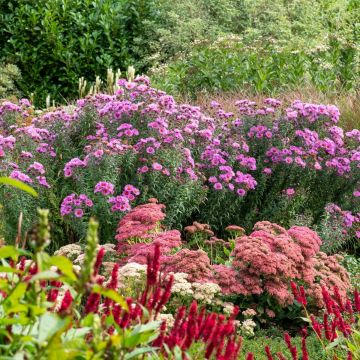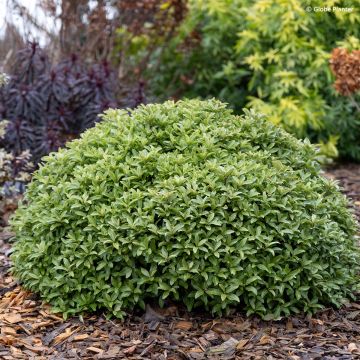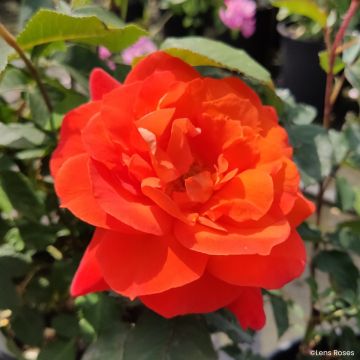

Snow Banana Seeds - Ensete glaucum - Snow Banana Tree
Snow Banana Seeds - Ensete glaucum - Snow Banana Tree
Ensete glaucum
False Banana, Snow Banana
Good quality seeds received within a reasonable timeframe. They have been sown, I am waiting for their germination.
Claude Tourreil, 10/04/2016
Special offer!
Receive a €20 voucher for any order over €90 (excluding delivery costs, credit notes, and plastic-free options)!
1- Add your favorite plants to your cart.
2- Once you have reached €90, confirm your order (you can even choose the delivery date!).
3- As soon as your order is shipped, you will receive an email containing your voucher code, valid for 3 months (90 days).
Your voucher is unique and can only be used once, for any order with a minimum value of €20, excluding delivery costs.
Can be combined with other current offers, non-divisible and non-refundable.
Why not try an alternative variety in stock?
View all →This plant carries a 6 months recovery warranty
More information
We guarantee the quality of our plants for a full growing cycle, and will replace at our expense any plant that fails to recover under normal climatic and planting conditions.
Would this plant suit my garden?
Set up your Plantfit profile →
Description
Originally from the mountains of China, Ensete glaucum, also known as Snow Banana, is a tall evergreen perennial with thick, glossy green leaves that can reach several metres in height. Its stem, or pseudo-trunk, is covered with a white wax. Fantastic in exotic settings, its growth rate is such that it already forms a beautiful plant in one season. It can be grown in large containers on the terrace or as an indoor plant, or in the ground with winter protection. This beautiful and fairly hardy plant requires warmth, fertile soil, and good drainage.
The Snow Banana, sometimes called Abyssinian Banana, is a semelparous plant (dies after fruiting) with tuberous rhizomes, native to the mountains of China, in the Yunnan province, on wooded slopes, up to an altitude of 2700 m (8858.3 ft). It is a large banana tree, without suckers at the base, reaching 4 to 7m (13.1 - 23ft) or more in its country of origin. In our climates, it rarely exceeds 4m (13.1 ft) in height and 2m (6.6 ft) in width. It is remarkable for its ornamental qualities and its fast growth. A seed planted in spring can grow into a plant of 1.50m (3.3ft) in just one summer. The leaves are particularly large 1.80m (5.9ft) long), long and wide, entire, alternate, glossy green on the top, paler and glaucous underneath. The pseudo-trunk formed by the overlapping and curled petioles of the leaves is covered with a white waxy layer, giving it a glaucous appearance. It can reach 5m (16.4ft) in height. The visible stump is yellow-green, stained with black-violet as the plant ages. It is a relatively hardy plant, evergreen in mild climates, capable of withstanding light frosts of around -6 to -8°C (21.2 - 17.6 °F), sometimes even less. Flowering, which is quite rare in our climates, occurs in summer on plants that are at least 2 years old, if the pseudo-trunk has not frozen. The inflorescence is cylindrical and can measure up to 2.5m (6.6ft) in length. They are adorned with large bracts, each counting 10 to 20 flowers. The flowering is followed by the formation of black-violet, grey-green fruits in the shape of bananas, approximately 9cm (3.5in) long and 3.5cm (1.2in) wide. The large seeds are black and spherical, with a diameter of 1.2cm (0.4in).
The Snow Banana is used in flower beds or as a standalone plant, even in cooler climates, but always planted in a sheltered location. By tying its leaves around the stem and protecting this bundle from winter moisture, it will survive the winter without damage. It alone creates a beautiful display on the terrace when placed in a large container. It can be stored in a cold greenhouse during the winter. In this usage, it pairs well with other orangery plants, such as oleanders, citrus trees, or Strelitzia reginae.
Flowering
Foliage
Plant habit
Botanical data
Ensete
glaucum
Musaceae
False Banana, Snow Banana
China
Other Thompson and Morgan seeds
View all →Planting and care
Sow the seeds of Snow Banana at any time of the year, after soaking the seeds for 24 hours in warm water. Use a peat-based compost. Bury the seeds at a depth of 6mm (0.2in). Enclose the sowing inside a polyethylene bag to keep the substrate moist. Germination is slow and irregular and can take 1 to 6 months at 26°C.
Each seedling that develops should be transferred to a terrine filled with well-drained compost, taking care not to damage the fragile roots. Then transplant into the final container or in the open ground, in a very mild climate.
Cultivation:
Snow Banana should be grown in full sun or partial shade, in a rich, moist, but well-drained soil, sheltered from the wind. Plants established in the open ground will be prepared to face the winter: gather the leaves around the pseudo-trunk, and protect everything with a bubble wrap or by enclosing straw in a transparent plastic sheet, so that rainwater cannot penetrate into the core of the boot. If the plant is grown in a container, overwinter it frost-free, in a well-lit room, reducing watering. If some leaves change colour in winter, it will not harm the plant's health.
Sowing period
Intended location
Planting & care advice
-
, onOrder confirmed
Reply from on Promesse de fleurs
Haven't found what you were looking for?
Hardiness is the lowest winter temperature a plant can endure without suffering serious damage or even dying. However, hardiness is affected by location (a sheltered area, such as a patio), protection (winter cover) and soil type (hardiness is improved by well-drained soil).

Photo Sharing Terms & Conditions
In order to encourage gardeners to interact and share their experiences, Promesse de fleurs offers various media enabling content to be uploaded onto its Site - in particular via the ‘Photo sharing’ module.
The User agrees to refrain from:
- Posting any content that is illegal, prejudicial, insulting, racist, inciteful to hatred, revisionist, contrary to public decency, that infringes on privacy or on the privacy rights of third parties, in particular the publicity rights of persons and goods, intellectual property rights, or the right to privacy.
- Submitting content on behalf of a third party;
- Impersonate the identity of a third party and/or publish any personal information about a third party;
In general, the User undertakes to refrain from any unethical behaviour.
All Content (in particular text, comments, files, images, photos, videos, creative works, etc.), which may be subject to property or intellectual property rights, image or other private rights, shall remain the property of the User, subject to the limited rights granted by the terms of the licence granted by Promesse de fleurs as stated below. Users are at liberty to publish or not to publish such Content on the Site, notably via the ‘Photo Sharing’ facility, and accept that this Content shall be made public and freely accessible, notably on the Internet.
Users further acknowledge, undertake to have ,and guarantee that they hold all necessary rights and permissions to publish such material on the Site, in particular with regard to the legislation in force pertaining to any privacy, property, intellectual property, image, or contractual rights, or rights of any other nature. By publishing such Content on the Site, Users acknowledge accepting full liability as publishers of the Content within the meaning of the law, and grant Promesse de fleurs, free of charge, an inclusive, worldwide licence for the said Content for the entire duration of its publication, including all reproduction, representation, up/downloading, displaying, performing, transmission, and storage rights.
Users also grant permission for their name to be linked to the Content and accept that this link may not always be made available.
By engaging in posting material, Users consent to their Content becoming automatically accessible on the Internet, in particular on other sites and/or blogs and/or web pages of the Promesse de fleurs site, including in particular social pages and the Promesse de fleurs catalogue.
Users may secure the removal of entrusted content free of charge by issuing a simple request via our contact form.
The flowering period indicated on our website applies to countries and regions located in USDA zone 8 (France, the United Kingdom, Ireland, the Netherlands, etc.)
It will vary according to where you live:
- In zones 9 to 10 (Italy, Spain, Greece, etc.), flowering will occur about 2 to 4 weeks earlier.
- In zones 6 to 7 (Germany, Poland, Slovenia, and lower mountainous regions), flowering will be delayed by 2 to 3 weeks.
- In zone 5 (Central Europe, Scandinavia), blooming will be delayed by 3 to 5 weeks.
In temperate climates, pruning of spring-flowering shrubs (forsythia, spireas, etc.) should be done just after flowering.
Pruning of summer-flowering shrubs (Indian Lilac, Perovskia, etc.) can be done in winter or spring.
In cold regions as well as with frost-sensitive plants, avoid pruning too early when severe frosts may still occur.
The planting period indicated on our website applies to countries and regions located in USDA zone 8 (France, United Kingdom, Ireland, Netherlands).
It will vary according to where you live:
- In Mediterranean zones (Marseille, Madrid, Milan, etc.), autumn and winter are the best planting periods.
- In continental zones (Strasbourg, Munich, Vienna, etc.), delay planting by 2 to 3 weeks in spring and bring it forward by 2 to 4 weeks in autumn.
- In mountainous regions (the Alps, Pyrenees, Carpathians, etc.), it is best to plant in late spring (May-June) or late summer (August-September).
The harvesting period indicated on our website applies to countries and regions in USDA zone 8 (France, England, Ireland, the Netherlands).
In colder areas (Scandinavia, Poland, Austria...) fruit and vegetable harvests are likely to be delayed by 3-4 weeks.
In warmer areas (Italy, Spain, Greece, etc.), harvesting will probably take place earlier, depending on weather conditions.
The sowing periods indicated on our website apply to countries and regions within USDA Zone 8 (France, UK, Ireland, Netherlands).
In colder areas (Scandinavia, Poland, Austria...), delay any outdoor sowing by 3-4 weeks, or sow under glass.
In warmer climes (Italy, Spain, Greece, etc.), bring outdoor sowing forward by a few weeks.





























































